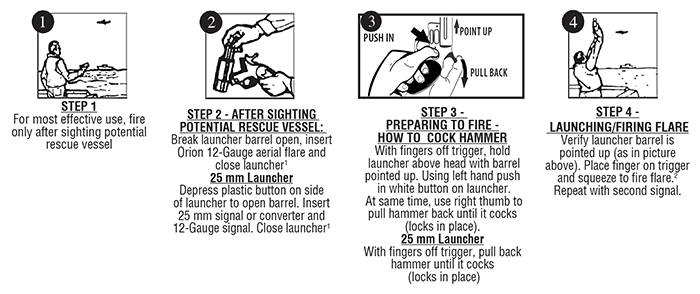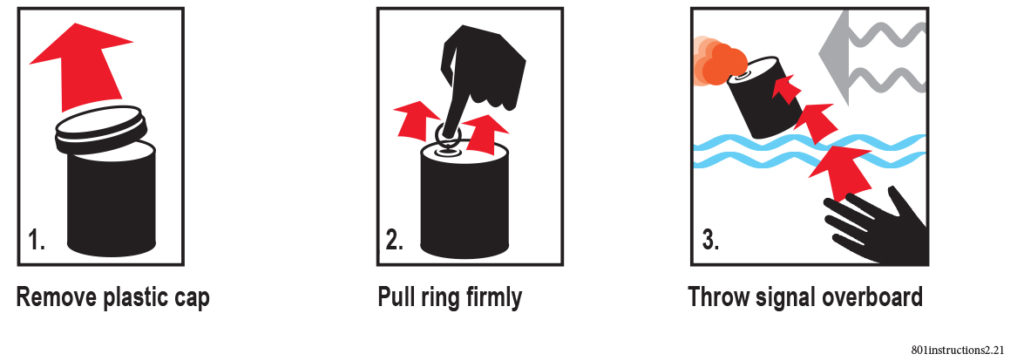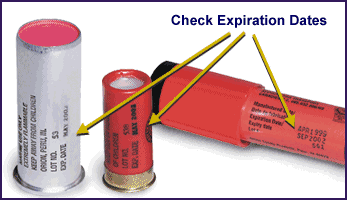MARINE FAQ
Are there cautions/warnings I should be made aware of before buying, using, or storing a marine flare (aerial or handheld)?
Warnings/Cautions
- Aerial and handheld flares are for outdoor emergency signaling only. These are not toys. Misuse can result in death/serious injury.
- Signal launchers launch burning flares at high velocity.
- Handheld flares produce hot flame and/or dense smoke.
- Keep out of reach of children.
- Keep away from heat, sparks, and open flames.
- Never point launcher at a person, animal, or anything flammable.
- Never store or carry launcher loaded.
- Do not load the launcher until immediately prior to use.
- Do not use where prohibited by law.
- It is illegal to ignite/fire distress signals in a non-distress situation.
- These products are not intended to be used as weapons and, if used for any purpose other than emergency marine signaling, may subject users to civil or criminal action including under local firearms laws.
- Store aerial and handheld flares onboard undercover in a secure, safe, dry place.
- Read and follow all instructions carefully.
Important Notice
Orion USCG Approved signals are produced and independently tested to the specifications provided by the Code of Federal Regulations (CFR) 46 Part 160. Signal performance, however, can be negatively impacted if such signals are not stored properly. They must be stored undercover in a secure, safe, dry location on your boat and should be removed during long periods of boat storage. All signals and launchers should be inspected at least once annually for damage caused by exposure to moisture or mishanding.
View our Safety Manual for additional safety information about Orion signals, including when and how to signal.
What are the basic principles of signaling?
The first purpose of distress signaling is to attract attention (Alert Signals). The second purpose, and therefore type of signal, is to provide a homing signal to guide the responding party to your boat (Locate Signals).
Remember, nothing can happen until someone’s attention is attracted. The most effective distress signals for attracting attention are aerial flares and parachute flares because they are moving, spectacular, and cover a large sighting area.
Once help is on the way, handheld red signal flares, orange smoke signals, and orange distress flags serve as beacons to help rescuers pinpoint your position and keep them on course.
For more information view our Understanding Locate vs. Alert Signals document.
What are the four main rules of signaling?
- Conserve your aerial signals until you are reasonably sure of being sighted. Wait until you see or hear a vessel or aircraft before using “one-time” signals.
- Stay with your boat if it is safe to do so. A boat is easier to spot than a swimmer!
- Using USCG approved marine signals such as Orion products will improve your chances, but anything that works is worth trying. USE COMMON SENSE! Shout, flash your running lights, wave a piece of clothing, use your windshield as a mirror, flash a flashlight … or ANYTHING ELSE that’s available to attract attention. Above all, DON’T PANIC!
- Familiarize yourself with your signals before you leave the shore. Time is important in an emergency and shouldn’t be spent reading instructions.
When do I use/launch an aerial signal?
Aerial flares should be fired after sighting or hearing a potential rescue vessel. To attract attention to your distress situation, the USCG recommends that you fire two aerial flares – one immediately after the other – so rescuers can confirm the sighting and the direction of the signal. Parachute flares do not need to be fired in twos, since a parachute flare has an adequate burn time (25 to 30 seconds) to confirm sighting and position.
Remember, search and rescue missions often establish grid search patterns, which means you may see the same aircraft two or three times, coming from different directions. Do not waste aerial flares if the aircraft has initially passed you buy. Carrying extra pyrotechnic signals onboard will improve your chances of being sighted.
When do I use/ignite handheld flares?
Orion handheld signal flares are intended as homing signals to pinpoint your position. The surface-to-surface sighting range on the water is approximately three to five miles, depending on boat elevation. If a rescuer is five miles away and running at 20 miles per hour, it will take 15 minutes to reach you. Therefore, you should have at least 12 minutes (total burn time) of signals onboard to maintain a strong homing signal until help arrives.
How do I safely and effectively use/launch an Orion aerial marine signal?
Orion sells five different types of aerial signals, with some requiring a launcher (such as a 12-gauge or 25mm safety launcher or the 16.5mm pen-style launcher for the Pocket Rocket). The use instructions are different for each of the five different types of aerial signals. Before buying, using, or storing any Orion aerial signals, make certain all cautions, warnings, and use instructions are read, understood, and followed.
ORION AERIALS FIRED FROM EXTERNAL LAUNCHERS
Orion launchers, whether 12-gauge, 25mm, or the 16.5mm pen-style Pocket Rocket launcher, are designed to be used with Orion signals only. Use of any other signal or shell with an Orion launcher is dangerous and voids all claims and warranties. Orion signals may only be fired from Orion launchers.
12-Gauge Orion Launchers with No External Hammer Safety Lock (generally pre-2021):

- FOR MOST EFFECTIVE USE, fire only after sighting a potential rescue vessel. Do not load until ready to fire.
- AFTER SIGHTING POTENTIAL RESCUE VESSEL break launcher barrel open, insert Orion 12-gauge aerial flare and close launcher (if barrel does not close, DO NOT FORCE. Check that the signal is pushed all the way in, if barrel will not close fully, carefully remove signal and try another – Repeat Step 2).
- HOW TO COCK HAMMER ON LAUNCHER: With your fingers off the trigger, hold the launcher above your head with the barrel pointed up, pull the hammer back until it cocks (locks in place).
- LAUNCHING/FIRING FLARE: verify launcher barrel is pointed up (as in picture 3 above). Place your finger on the trigger and squeeze to fire the flare. Repeat with the second signal.
If the signal does not fire after following these instructions and the trigger has been squeezed, DO NOT IMMEDIATELY OPEN THE LAUNCHER. While rare, a hang-fire (delayed firing after squeezing the trigger) can be very dangerous. Point the launcher overboard towards the water, wait at least five seconds, then open the launcher and replace the signal (Repeat Step 2).
12-Gauge Orion Launchers with External Hammer Safety Lock (generally 2021 and later) and 25mm Launchers:

- FOR MOST EFFECTIVE USE, fire only after sighting a potential rescue vessel.
- AFTER SIGHTING POTENTIAL RESCUE VESSEL break launcher barrel open, insert applicable Orion 12-gauge or 25 mm aerial flare and close launcher (if barrel does not close, DO NOT FORCE. Check that the signal is pushed all the way in, if barrel will not close fully, carefully remove signal and try another – Repeat Step 2).
- HOW TO COCK HAMMER ON LAUNCHER: With your fingers off the trigger, hold the launcher above your head with the barrel pointed up. Using your left hand push in the white button on the launcher. At the same time, use your right thumb to pull the hammer back until it cocks (locks in place).
- LAUNCHING/FIRING FLARE: verify launcher barrel is pointed up (as in picture 4 above). Place your finger on the trigger and squeeze to fire the flare. Repeat with the second signal.
If the signal does not fire after following these instructions and the trigger has been squeezed, DO NOT IMMEDIATELY OPEN THE LAUNCHER. While rare, a hang-fire (delayed firing after squeezing the trigger) can be very dangerous. Point the launcher overboard towards the water, wait at least five seconds, then open the launcher and replace the signal (Repeat Step 2).
ORION AERIALS WHICH DO NOT REQUIRE EXTERNAL LAUNCHERS
Orion Skyblazer II Red Aerial Signals (XLT):

- Press top of red launch tube down with thumb to unlock sleeve – launch tube will drop down.
- Holding orange sleeve firmly with one hand, use other hand to pull down on red cap to lock sleeve in place.
- Grasp red launch tube firmly, with little finger braced in finger dimples and thumb/forefinger pressed against friction grip on orange sleeve. Hold above head off to side and unscrew red cap with free hand. Ignition chain will drop down.
- While holding above head off to side and pointing launch tube/sleeve straight up, with face turned away from signal, maintain firm grip and pull chain down sharply to launch aerial flare. There will be recoil as the flare launches so be certain to maintain a firm grip on red launch tube throughout launch process.
Orion SOLAS Rocket:

- Hold signal with arrow directed upwards and unscrew the red bottom end cap.
- Hold signal firmly overhead, pointed straight up, and squeeze trigger against the body of the signal.
- Fire vertically! Functions immediately.
How do I safely and effectively use/ignite an Orion handheld marine signal?
Orion sells two different types of marine handheld signals:
- Handheld red signal flares which are USCG approved for day and night use.
- Handheld orange smoke flares which are USCG approved for daytime use only.
Whether we are talking about Orion handheld red flares or orange smoke flares, both are ignited in the same manner. Before buying, using, or storing any Orion handheld marine signals, make certain all cautions, warnings, and use instructions are read, understood, and followed.
Use Instructions:

- Grasp bottom of flare below the holding line on the label. Remove the black lid on the cap.
- Twist cap, remove, and save to ignite flare. Point flare away from your face and body. Aim downward.
- In a downward motion, strike the black igniter button on top of the flare with the abrasive red phosphorus sticker on the cap. Hold burning flare over the side of the boat. Do not wave overhead. Avoid breathing smoke.
How do I safely and effectively use/ignite an Orion SOLAS handheld or floating smoke flare?
Before buying, using, or storing any Orion signals, make certain all cautions, warnings, and use instructions are read, understood, and followed.
Orion SOLAS Handheld Flare (Item #813, 814, and 826):

- Pull both ends of the flare in opposite directions until engaged.
- Hold signal with arrow pointed upwards. Remove red cap at bottom, releasing pull string and ring.
- Hold flare over head and away from face and body. When a rescue vessel is spotted, pull ring straight down.
- With back to wind, continue to hold flare overhead and away from body. Do not wave flare.
Orion SOLAS Handheld Flare (Item #802, 812, 807, 824,and 826):

- Pull both ends of the flare in opposite directions until engaged.
- Hold signal with arrow pointing upwards. Remove the top cap.
- Hold the flare firmly and pull the ring at 45°.
- Hold the flare downwind, by the handle. Ignition happens after 3 seconds.
Orion SOLAS Floating Smoke Flare:

- Remove plastic cap.
- Pull ring firmly.
- Throw signal overboard.
How should I store my Orion signals?
First, before buying, using, or storing any Orion signals, make certain all cautions, warnings, and use instructions are read, understood, and followed.
WARNINGS / CAUTIONS
- Aerial and handheld flares are for outdoor emergency signaling only. These are not toys, misuse can result in death/serious injury. Signal launchers launch burning flares at high velocity. Handheld flares produce hot flame and/or dense smoke.
- Keep out of reach of children. Keep away from heat, sparks, and open flames.
- Never point a launcher at a person, animal, or anything flammable.
- Never store or carry launcher loaded. Do not load the launcher until immediately prior to use.
- Do not use where prohibited by law. It is illegal to ignite/fire distress signals in a non-distress situation.
- These products are not intended to be used as weapons and, if used for any purpose other than emergency marine signaling, may subject users to civil or criminal action including under local firearms laws.
- Store aerial and handheld flares onboard undercover in a secure, safe, dry place.
- Read and follow all instructions carefully.
IMPORTANT NOTICE – Orion USCG Approved signals are produced and independently tested to the specification provided by the Code of Federal Regulation (CFR) 46, Part 160. Signal performance, however, can be negatively impacted if such signals are not stored properly. They must be stored undercover in a secure, safe, dry location on your boat and should be removed during long periods of boat storage. All signals and launchers should be inspected at least once annually for damage caused by exposure to moisture or mishandling.
As this relates to storage, there are two factors that must work together. Pursuant to the USCG regulations (33 CFR 175, 120), the signals must be stored onboard in an “accessible place”. So wherever and however the signals are stored onboard, they must be readily accessible to the boater in times of emergency and kept out of reach of children. Both factors are critically important.
To maximize the performance of Orion signals, during the boating season it is recommended that aerial and handheld Orion signals be stored onboard, undercover in a secure, safe, dry place. It is further recommended that Orion signals be removed from the vessel during long periods of boat storage so long as they are always secured away from children. Storing the aerial shells separate from the launcher, when applicable, can increase security.
Will my visual distress signals expire?
Pyrotechnic signaling devices (including aerial flares and handheld signals) expire 42 months after the date of manufacture in accordance with the Coast Guard requirements. Typically, this means that you must replace your flares every three boating seasons.
How do I find expiration dates on my Orion Signals?
Safe replacement and disposal of pyrotechnic signaling devices begins by checking the expiration date on your product. Pyrotechnic signaling devices (including aerial flares and handheld signals) expire 42 months after the date of manufacture in accordance with the United States Coast Guard requirements. Typically, this means that you must replace your flares every three boating seasons. USCG regulations require that each pyrotechnic signaling device must be stamped with the expiration date.
Check the expiration dates on your flares and signals as shown below. If they have expired or will expire during the boating season, you must replace them…it’s the law! In addition to printing the expiration date on the individual product, Orion also prints the date on all product packaging.

How do I dispose of expired marine pyrotechnic signals?
To dispose of expired marine pyrotechnic distress signals, Orion recommends the following methods:
- Ignite handheld signals flares on land away from regulated waters in a safe area (away from combustible materials, fuel, or fumes), much the same as highway flares would be ignited.
- Contact local law enforcement or the fire protection agency for their advice on proper visual distress signal disposal.
- Retain flares for back-up use to expand signaling time in the event of an emergency.
- NEVER jettison visual distress signals overboard.
- NEVER activate marine flares in a non-emergency situation on or near regulated water.
- NEVER dispose of flares in household trash.
Is there anything I should do regularly to check my Orion signals to assure performance?
Annual Signal Inspection
Before each boating season, check the dates and the condition of your signaling equipment as instructed below. If signals are expired or will expire during the season, replace them immediately!
Test Your Launcher
We recommend prior to each boating season, every signal launcher be inspected to make sure it is fully functional. To do so:
- BE SURE THE FIRING PIN ON LAUNCHER IS NOT BENT.
- Open the barrel and insert a 12-gauge or 25mm Orion signal, as applicable, into the barrel.
- Be sure the signal is fully inserted into the barrel.
- Close the launcher barrel.
If the barrel snaps fully shut, it is in good operating order. Open the barrel, REMOVE THE SIGNAL AND SAFELY STORE IT WITH YOUR OTHER SIGNALS.
If the barrel does not fully close, DO NOT FORCE IT. Check that the signal is pushed all the way into the barrel. If this does not help, REMOVE THE SIGNAL AND SAFELY STORE IT WITH YOUR OTHER SIGNALS. Contact Orion for replacement instructions. DO NOT STORE LAUNCHER LOADED.
Check Your Handheld Flares
Check that moisture, mishandling, or improper storage has not corrupted the flare body. These flares are waterproof but extreme conditions can have a negative impact on their performance and shelf life.
Acquaint Yourself With Operation Of Signaling Equipment
Prior to each season and before an emergency occurs, read the warnings and instructions on all your signals. Family and visiting boaters, not including children, should also be made aware of location, warnings, and use instructions of all safety gear.
What if my Orion launcher doesn't work or I have concerns about functionality?
Lifetime Launcher Warranty & Service Program
Orion 12-gauge and 25mm launchers carry a lifetime warranty if used exclusively with applicable Orion aerial signals. In addition, the Orion Launcher Service Program allows customers to send their launchers to Orion in the off-season to verify functionality.
The launchers are run through a battery of tests to make certain performance has not degraded over time due to extreme environment, use, or storage conditions. If you have a launcher that has failed or if you simply want your launcher serviced, please send your launcher (verify it is empty with no signals in the chamber) to the following address with a note explaining the launcher deficiency or service request and your return address.
Orion Launcher Service Program
Orion Safety Products
P.O. Box 1047
Easton, MD 21601-8918
